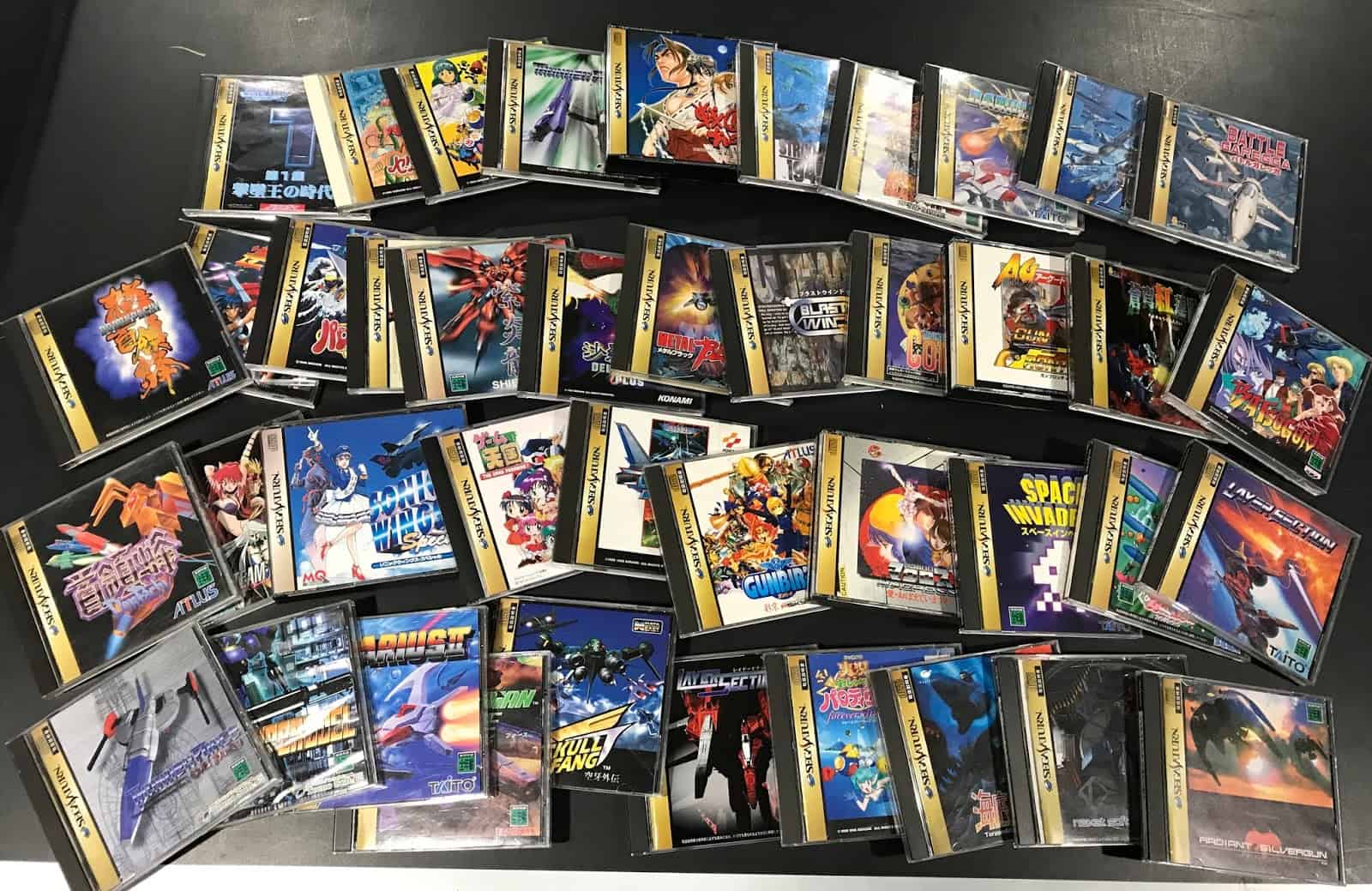Shoot ’em up games, STGs, or Shmups; whatever players happen to call them, the fact remains that the shoot ’em up, or Shmup, genre has been around almost as long as video games have existed. Though the arcade has always been the de facto home of Shmups and is still where most hardcore genre enthusiasts prefer to experience the best titles, there’s a long history of excellent Shmup ports on consoles dating all the way back to the NES and Sega Master System. The beginning of the 5th console generation and shift from standard ROM cartridges to the CD-ROM format on both the Sony PlayStation and Sega Saturn would result in arcade ports hitting living rooms faster and better than ever before. When it comes to console ports of the best arcade Shmups, no other hardware can compare to the Sega Saturn.
Though the Saturn failed to catch on in the West in the same way that Sony’s PlayStation did, the console’s success in Japan would result in Eastern players receiving a whole slew of incredible Shmup conversions on the console that never left their native Japan. Coincidentally, many of these games were the first wave of a new breed of Shmup known as “danmaku”, or, “Bullet-Hell”, foregoing the memorization of classic Shmups in favor of overwhelming the player with bullets and forcing them to read patterns and micro-thread through openings. In focusing on the best Saturn Shmups, genre fans may notice that there is a distinct lack of Psikyo titles on the list, which comes as a result of many of those games receiving better ports on Sega’s next console (the Dreamcast) thanks to the Sega Saturn’s relatively short life cycle.
Where applicable, this list will note whether these titles are playable on modern consoles and PCs.
Cotton 2: Magical Night Dreams
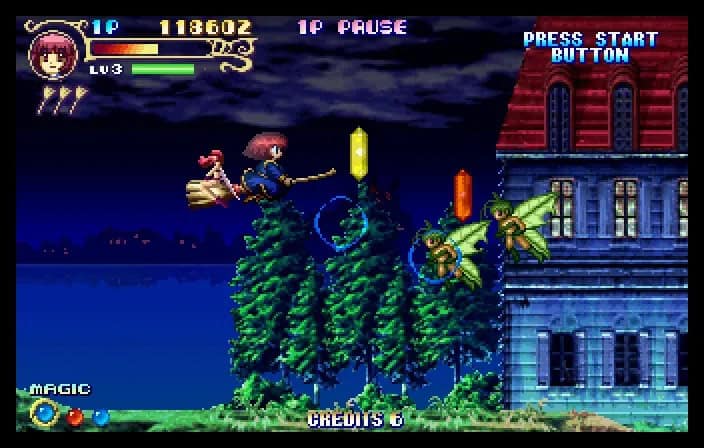
©Cotton 2 gameplay screenshot - Original
- Release Date — December 4, 1997
- Availability on Modern Platforms — PC, PS4, Nintendo Switch
Choosing between either Cotton 2 or its remix Cotton Boomerang is tough given how excellent both titles are, but the original Cotton 2 wins out for being the first of the two and a massive upgrade from the original Cotton: Fantastic Night Dreams. A horizontal Shmup starring the titular witch Cotton (and rival witch April as Player 2), Cotton 2 has a decidedly fantasy-themed flair and a unique system where players utilize various forms of elemental magic rather than the standard bomb attacks. The title is one of the more beginner-friendly Shmups on the Saturn and a great entry point for players looking to get into the genre with a less-demanding game featuring bright and colorful visuals. Long before Cave gave players Deathsmiles, Cotton was the original magical horizontal Shmup.
Kingdom Grand Prix
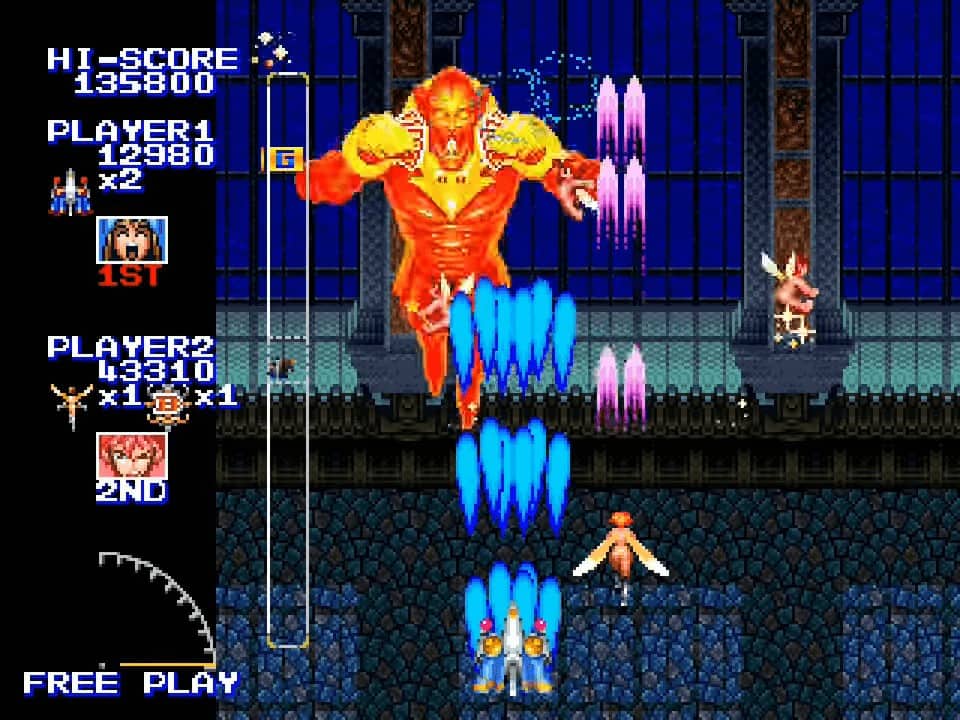
©Kingdom Grand Prix gameplay screenshot - Original
- Release Date — June 14, 1996
- Availability on Modern Platforms — N/A
Otherwise known as Shippuu Mahou Daisakusen Kingdom-Grandprix, Kingdom Grand Prix is an interesting game in the catalog of legendary Shmup developer Raizing and a unique title among Shmups in general. Unlike most other Shmups, which traditionally revolve around progressively harder stages that feature a screen-filling boss fight at the end, Kingdom Grand Prix is a blend of Shmup and Racing games, with some stages forcing players to compete against either other players or the computer to race to the end of the stage all while needing to take out enemy threats. The Saturn version is arguably the definitive release of the game thanks to the fact that it includes the “Shooting Only” mode that removes the racing component and allows players to focus purely on the excellent Shmup gameplay on offer.
DonPachi
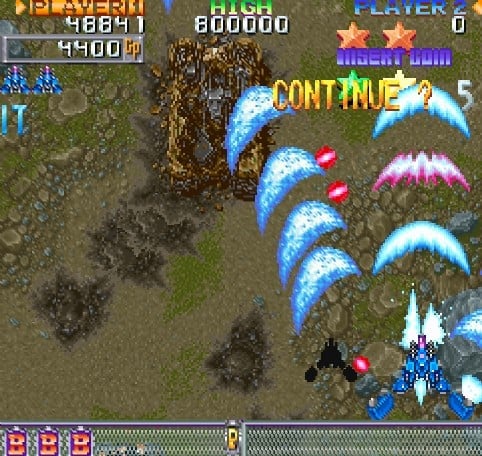
©Donpachi gameplay screenshot - Original
- Release Date — April 26, 1996
- Availability on Modern Platforms — N/A
When discussing the best Sega Saturn shmups, it’s impossible not to mention the debut title from Cave and the landmark title in developing the “danmaku” style, DonPachi. After finishing work on Batsugun as the final game from legendary Shmup developer Toaplan, several of that game’s key staff would form their own new studio. That new studio would be none other than Cave, and its first game DonPachi is commonly accepted as the foundational game in the “Bullet-Hell” style of Shmup. At its core, DonPachi is an incredibly fast-paced and satisfying military-themed Shmup that allows players to switch between two shot types — a standard, rapid-fire stream of bullets and a more concentrated blast that deals more damage but slows down player movement. DonPachi is an incredible game in its own right, and the Saturn port features a special mode that features a more accessible difficulty curve.
Blast Wind
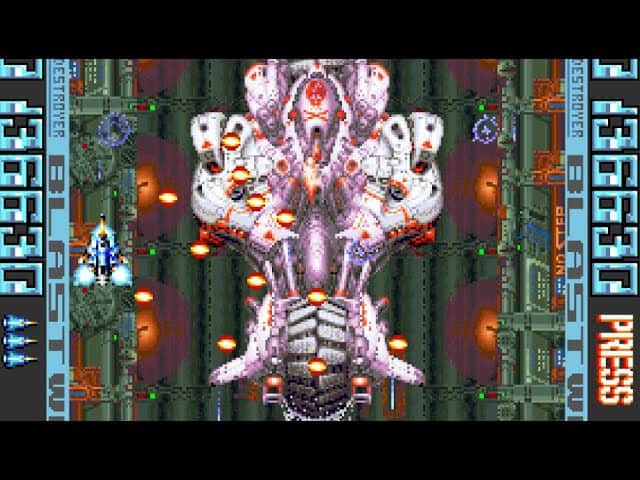
©Blast Wind gameplay screenshot - Original
- Release Date — January 17, 1997
- Availability on Modern Platforms — N/A
Although it often gets some undue derision from Shmup enthusiasts thanks to its lack of significant challenge, Blast Wind is one of the more unique and enjoyable Shmups on the Sega Saturn. What sets Blast Wind apart from competitors are its branching paths, with some stages featuring more than one alternate route for players to take as they make their way toward each level’s final boss encounter. The title also features a unique story along with beginning and ending cutscenes that add a nice bit of narrative context to what’s otherwise a fairly rote shoot ’em up game. Blast Wind may be a little on the easier side, but its excellent visuals and soundtrack, as well as its flirting with non-linear progression and multiple pathways to victory, make it a hidden gem in the Saturn library.
RayStorm/Layer Section II
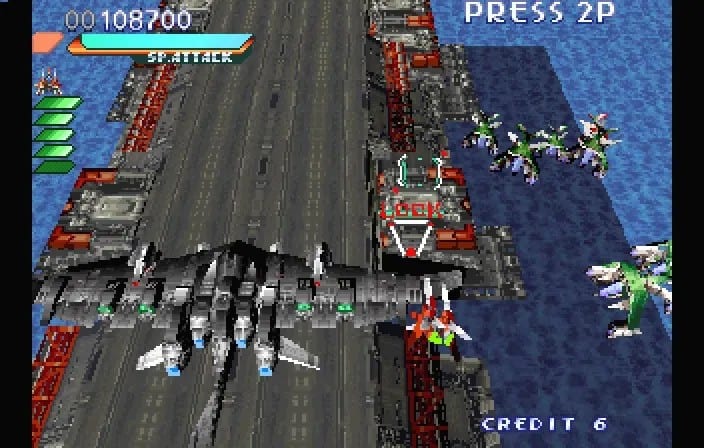
©RayStorm gameplay screenshot - Original
- Release Date — October 30, 1997
- Availability on Modern Platforms — PC, PS4, Nintendo Switch
Arriving just 2 years after its predecessor, RayStorm is the 3D sequel to the excellent 2D Shmup RayForce. Though it doesn’t quite reach the same highs as RayForce, RayStorm is an essential Shmup in the Saturn library thanks to its excellent 3D visuals and soundtrack. Additionally, the series’ unique homing-missile mechanic sees a further evolution in RayStorm thanks to the inclusion of 3D visuals, with players having greater control over how they scan enemies and include them in a barrage of ordinance. Interestingly, the Saturn port of the title (known as Layer Section II to continue the naming convention of the system’s port of RayForce) would be released only in Japan, leaving PlayStation owners as the only Western players to get the game (arriving as RayStorm in North America and Galactic Attack in PAL regions).
Shienryu
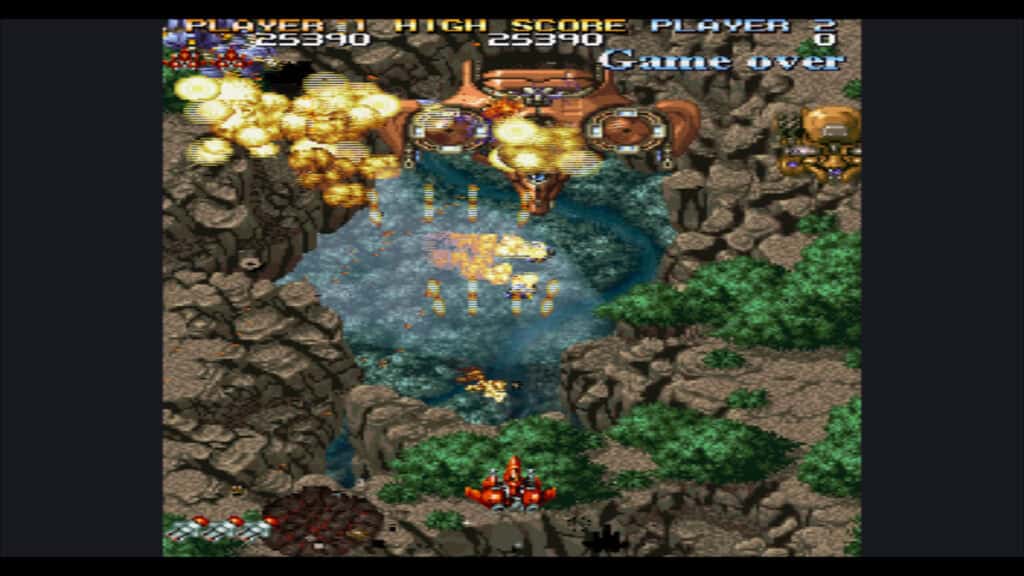
©Shienryu gameplay screenshot - Original
- Release Date — June 27, 1997
- Availability on Modern Platforms — N/A
Prior to releasing the excellent Macross M3 and Triggerheart Excelica (famously the last official release for the Sega Dreamcast), developer Warashi would deliver what is arguably its best title on the Sega Saturn in Shienryu. Though Shienryu is a fairly standard Shmup in comparison to other titles from the era, its quality helps it to stand out from the pack as a game that handles the genre’s fundamentals perfectly. The stages in Shienryu are fast-paced and each features a compelling boss encounter at the end, the game’s weapon and upgrade system are easy to wrap one’s head around (with only three weapon types and a different bomb type for each), and the visuals and soundtrack rank as some of the best of any Sega Saturn Shmup. Ultimately, Shienryu is a great example of the beauty in simplicity.
Hyper Duel
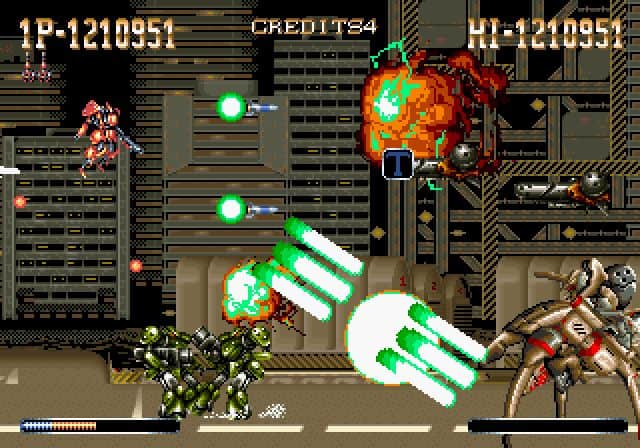
©Hyper Duel gameplay screenshot - Original
- Release Date — November 22, 1996
- Availability on Modern Platforms — N/A
Thanks to its Japanese exclusivity, Hyper Duel now stands as one of the most expensive physical Saturn games, with copies ranging anywhere from $600 to $1200 depending on condition and whether they’re still factory-sealed. Regardless of its collectible nature, though, Hyper Duel is a phenomenal Shmup that features two distinct modes for the player ship. In Hyper Duel, players can switch on the fly between a more agile aircraft and a slower, but immensely more powerful mech. The two distinct modes and their complimentary abilities depending on individual stages make Hyper Duel similar to the Macross/Robotech Shmups of the era, but its visuals, presentation, and gameplay are significantly more polished than any of the officially licensed Macross titles.
Metal Black
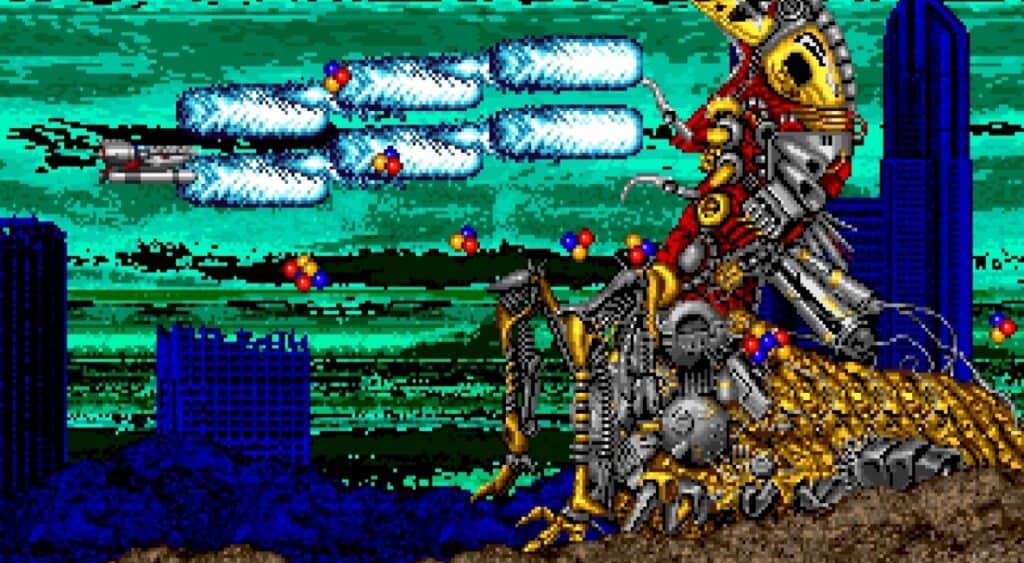
©Metal Black gameplay screenshot - Original
- Release Date — May 24, 1996
- Availability on Modern Platforms — PC, PS4, Nintendo Switch, Xbox One
It’s no secret that Taito were on a hot streak in the early-to-mid 1990s in terms of their Shmups, and Metal Black is one of the best. Originally released in 1991 for the arcade, the Saturn port would arrive in 1996 courtesy of conversion specialists Ving. As a budget title, the game found a dedicated following of Saturn Shmup players thanks to its challenging difficulty, eye-popping visuals, and unique story and aesthetic. Essentially, Metal Black takes place after a devastating meteorite shower on Earth gives way to cybernetic alien invaders that emerge from the crashed meteorites and attempt to destroy all life on Earth and terraform the planet. Accordingly, the enemy and boss designs in Metal Black are some of the best in the genre, and the gameplay only serves to provide an excellent foundation for the game’s unique aesthetic.
Thunder Force Gold Pack 2
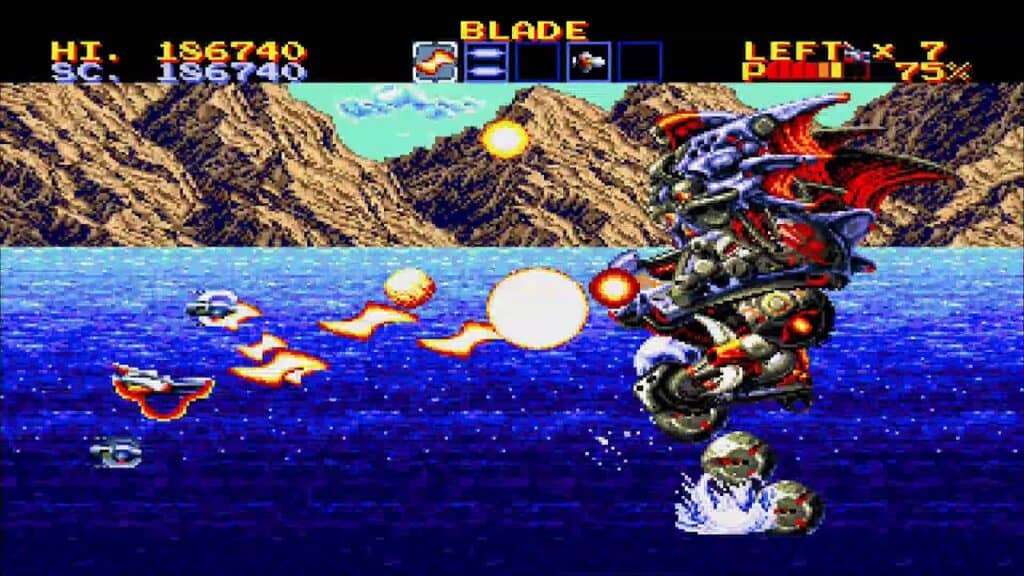
©Thunder Force IV gameplay screenshotq - Original
- Release Date — December 6, 1996
- Availability on Modern Platforms — Nintendo Switch
It might seem strange to include a compilation of older games on a list of the best Sega Saturn Shmups instead of including phenomenal titles like Sengoku Blade or Strikers 1945 II, but Thunder Force AC and Thunder Force IV are such legendary and timeless Shmups that their inclusion on this list is a necessity. The Saturn would get two separate collections featuring the excellent Thunder Force series, Thunder Force Gold Pack 1 and Thunder Force Gold Pack 2, and the second of these collections is a must-have in any Shmup fan’s Saturn library. Other than the Genesis classic Thunder Force IV, Gold Pack 2 includes Thunder Force AC, the arcade version of Thunder Force III. Thunder Force AC isn’t just the best of the Thunder Force games, it’s arguably one of the greatest Shmups ever made and a triumph on the part of developer Technosoft.
RayForce/Layer Section
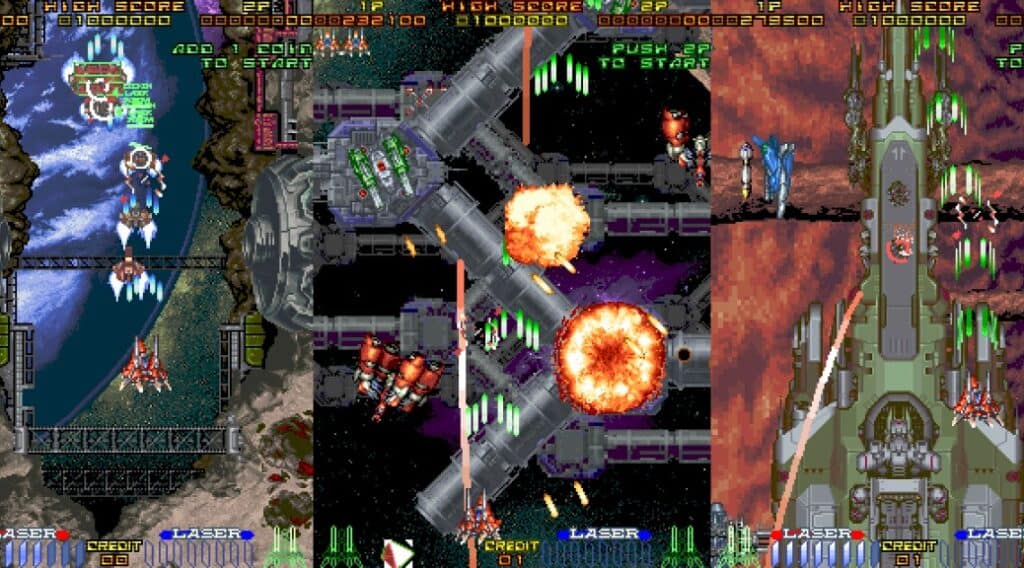
©RayForce gameplay screenshot - Original
- Release Date — November 29, 1995
- Availability on Modern Platforms — PC, PS4, Nintendo Switch
Despite its sequel and prequel featuring more advanced 3D visuals and enhancements to the series’ signature lock-on mechanic, the original game in the Ray series is still the best of the trilogy thanks to its timeless sprite-based visuals and pitch-perfect Shmup gameplay. RayStorm is an impressive achievement on both a technical level and from a gameplay standpoint, as its difficulty and pacing are suited to a more enjoyable experience than many other challenging Shmups and do a great job of introducing and acclimating the player to mixing up the standard Vulcan shot with the lock-on homing missile. Further, it would be a critical oversight to not mention RayForce‘s unbelievable soundtrack, which stands out as one of the best OSTs of the genre.
Soukyugurentai/Terra Diver
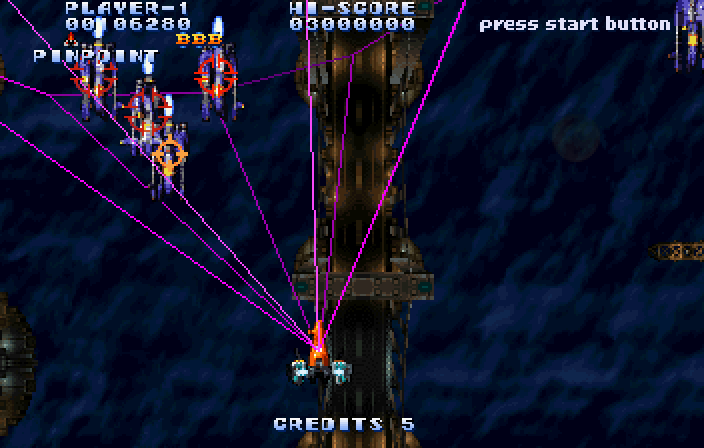
©Soukyugurentai gameplay screenshot - Original
- Release Date — February 7, 1997
- Availability on Modern Platforms — N/A
One of the only other Shmups of the era to introduce a blending of standard fire and a separate lock-on mechanic is the phenomenal Soukyugurentai, otherwise known as Terra Diver. Soukyugurentai comes from none other than legendary Shmup developer Raizing. Along with Toaplan, Taito, and Cave, few other developers are as instrumental in guiding the direction of the Shmup genre’s development and innovation as Raizing, and Soukyugurentai serves as a perfect example of the company’s genius. Interestingly, Soukyugurentai mixes a primarily 2D visual approach with some 3D elements (specifically, the homing “laser web” that players have to use to scan and lock on to enemies), and its gameplay might actually surpass the game that so clearly inspired it — RayForce.
Batsugun
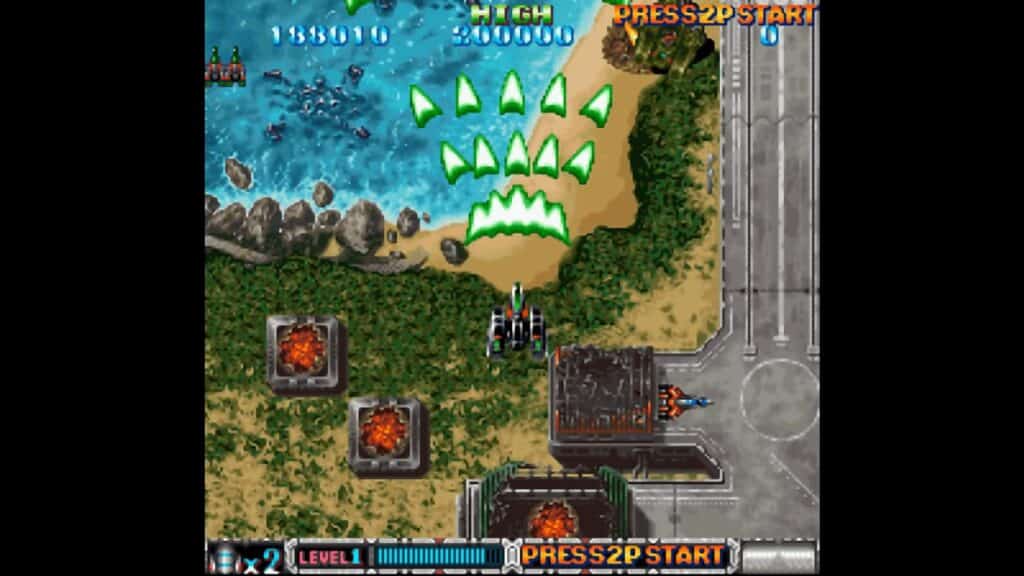
©Batsugun gameplay screenshot - Original
- Release Date — October 25, 1996
- Availability on Modern Platforms — PC, PS4, Nintendo Switch
The final title from legendary Shmup developer Toaplan before several of the key staff left to form Cave, Batsugun is one of the best and most important Shmups to ever release. Additionally, Batsugun introduces a unique blending of genres that few other games have attempted since its release. Commonly accepted as the first “true” danmaku-style “Bullet-Hell” shmup, Batsugun continues the natural evolution of classic Toaplan gameplay that had progressively become more and more intense in every subsequent release since debuting with Tiger-Heli in 1985. The game’s bright visuals and onslaught of bullets and particle effects are an absolute feast for the eyes, and the mixing of RPG-style leveling up and character progression with classic, tightly-tuned Shmup gameplay makes Batsugun one of the best games of the genre, both during its time and into the modern era.
Battle Garegga
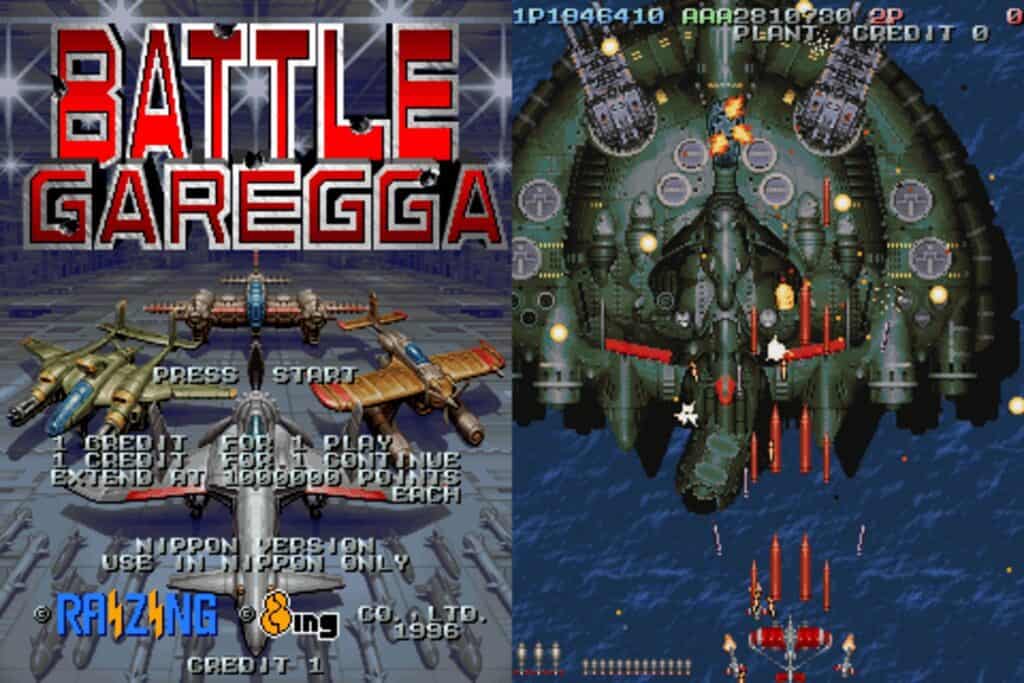
©Battle Garegga gameplay screenshot - Original
- Release Date — February 26, 1998
- Availability on Modern Platforms — PS4, Xbox One
The conversation about the “greatest Shmups of all time” tends to feature the same handful of titles in discussion: Batsugun, DoDonPachi, and the legendary Battle Garegga. Another of Raizing’s impeccable genre titles, Battle Garegga is one of the most difficult Shmups ever made in addition to being one of the most mechanically-dense. Unlike most other games in the genre, Battle Garegga actually punishes the player for doing to well, to the point where failing to master the game’s obtuse and atypical mechanics can result in the game becoming outright impossible in later stages. The only way to avoid this is to strategically lose at specific points and forego picking up power-ups and score multipliers to “trick” the game’s AI into not making things too difficult.
Outside its notoriously complex and different scoring system and mechanics, though, Battle Garegga is a game whose polish in every element shines through. The piloting of player ships and shooting both feel incredibly responsive, stages are lengthy without being too arduous or tiring, and the boss fights introduce some of the greatest spectacle ever seen in a Shmup. The Saturn version also features some unique settings that make the experience slightly easier than it is in the arcade, though the game does suffer from some slowdown in its conversion to home console hardware.
DoDonPachi
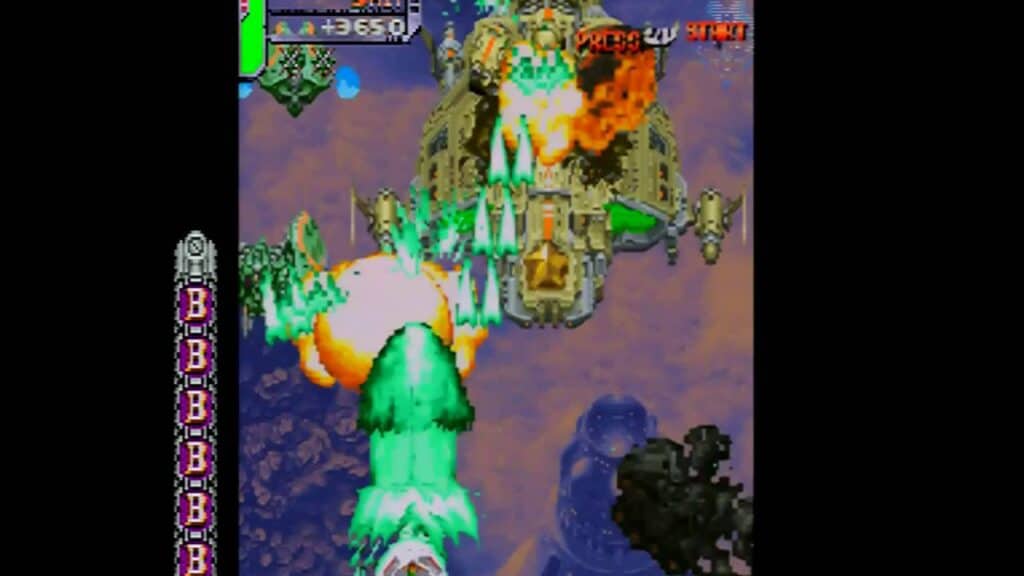
©Dodonpachi gameplay screenshot - Original
- Release Date — September 18, 1997
- Availability on Modern Platforms — N/A
What Cave introduced to players in the original DonPachi is only further evolved and improved in the timeless DoDonPachi. Along with Battle Garegga and Batsugun, DoDonPachi is an incredibly important and formative game in the development of the Shmup genre and the switch from memorization-based gameplay to the modern “Bullet-Hell” style. Similar to its predecessor DonPachi, DoDonPachi is a futuristic military Shmup where the player chooses one of three ships, each of which has a signature standard shot as well as a concentrated fire mode that deals more damage at the expense of slowing down movement speed. Balancing these two fire types is critical to success, as is using the limited number of bombs that the player has to clear the screen of bullet waves that are seemingly impossible to dodge.
Though the DonPachi series would go through several iterations before eventually reaching its peak in the near-perfect DoDonPachi DaiOuJou, DoDonPachi represents Cave’s first steps toward greatness and lays the foundation for a whole slew of other legendary Shmup titles that the developer would release over the coming decade. Aside from its importance to both the Cave-style of Shmups and the genre, though, DoDonPachi is an incredibly good-looking and good-sounding Shmup whose Saturn port is impressive, with it playing almost identically to the original arcade version and even featuring support for TATE mode.
Radiant Silvergun
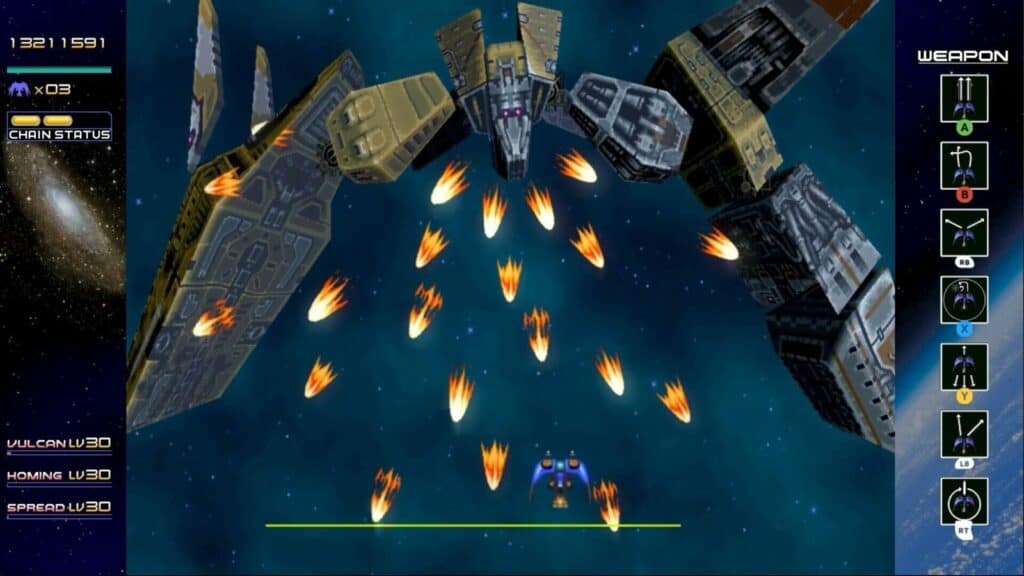
©Radiant Silvergun gameplay screenshot - Original
- Release Date — July 23, 1998
- Availability on Modern Platforms — PC, Nintendo Switch, Xbox 360
It’s impossible to make a list of the best Saturn Shmups and not include what many consider to be developer Treasure’s magnum opus, Radiant Silvergun. Like Batsugun before it, Radiant Silvergun flirts with some RPG mechanics in terms of its character progression and powering up, awarding the player experience for defeating enemies with each of the game’s six different shot types. Further, combining any three shot types results in the player being able to use a sword that both cancels bullets and destroys enemy targets, resulting in the need to strategically level up weapons and switch to the sword on the fly when the player runs out of options for defensive maneuvering. Radiant Silvergun also lays the foundation for Treasure’s other notable Shmup, Ikaruga, and together both titles often rank as some of the greatest games in the genre.
That said, Radiant Silvergun is an incredibly long and arduous game to play, but that “gauntlet”-style nature of the campaign only adds to the rewarding feeling players get after mastering the game’s mechanics and understanding which shot types to prioritize in terms of leveling-up and progression. In fact, some bosses become incredibly arduous in the later stages of the game if players don’t prioritize the correct shot types, resulting in those fights becoming grueling tests of endurance. Radiant Silvergun is not an easy Shmup, but it is arguably the Saturn’s best, and its exclusivity to the system makes it an important part of the console’s library.
The image featured at the top of this post is ©Sega Saturn CD-ROM cases.
